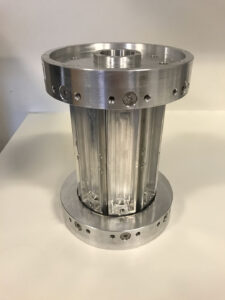Samson to test slurry analysis technology this year

Samson Agro saw its plans to commercialise its new slurry analysis technology in 2022 affected by shortage of components and lack of field testing possibilities.
Danish slurry machinery specialist Samson Agro is working on a new technology for online and real-time slurry analysis called SlurryLab. The technology, initially called ‘NPK sensor’, was awarded a silver innovation medal at the last physical Agritechnica that took place (2019).
The innovation was described in-depth on futurefarming.com before and the company planned to test prototypes in 2020 and 2021 in order to commercialise the SlurryLab system from 2022 onwards. Recent contacts with Samson and their development partner, Danish sensor specialist NanoNord, have learned that field testing and introduction have been postponed by two years.
Affected by ongoing Covid-19 restrictions

Niels Hagemann Haubjerg, product manager slurry tech at Samson Agro, told Future Farming that “due to continuing Covid-19 related restrictions and delivery problems of components and parts, we have not been able to perform the planned field testing until now. We did use the past year(s) to do more lab testing and to further improve the Tveskaeg Benchtop sensor as the sensor of the SlurryLab system is called. We are now able to determine the ammonium (NH4-N) concentration in ‘parts per million’ (ppm) in any type of slurry within 5 minutes with laboratory accuracy. We can also do that in 3 minutes with less accuracy.”
Hagemann Haubjerg also says that the means of measuring the slurry samples hasn’t changed. “It’s still the same small opening (12.5 mm) through which every slurry sample must flow to be able to measure its contents with the magnet of the sensor. In cooperation with Aarhus University, we have now validated the required sample size and the required number of samples per tank to be able to determine the composition of any type of slurry with the desired accuracy.”
When talking to NanoNord, the company that has developed the Tveskaeg Benchtop sensor and partner of Samson Agro on the project, NanoNord said: “Our work on these matters is still ongoing but we expect to have updated results over Spring and Summer when we expect to have some really exciting news to tell.”
Introduction in 2024
Samson Agro is planning to do the first field testing with the SlurryLab system this year and to test multiple systems in 2023. “The main issue remains to be the slurry handling and analysis as slurry differs so much from country to country and from region to region. Our biggest challenge is to build a robust technology to meet all the demands from farmers. Yet, as soon as we succeed in doing this, we have a technology that is more reliable and more accurate than Near Infrared (NIR) technology. A technology that is also promising to determine for instance protein and salt contents of liquids/substances.”
Samson Agro now plans to introduce its SlurryLab system in 2024 against similar prices as the NIR-systems on the market.
Join 17,000+ subscribers
Subscribe to our newsletter to stay updated about all the need-to-know content in the agricultural sector, two times a week.



